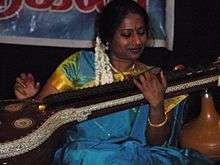Nirmala Rajasekar
Nirmala Rajasekar is an Indian Saraswati veena player in the Carnatic music style. Nirmala Rajasekar began her training in Veena at age 6 in Chennai from well known practitioners such as Sri Deva Kottai Narayana Iyengar and Smt. Kamala Aswathama. After moving to Bangalore, she learned at the Gana Mandira School in Basavangudi Smt. G Chennama and Smt. E. P. Alamelu.
Nirmala Rajasekar | |
|---|---|
 This is a picture of Nirmala Rajasekar performing live in the prestigious Janaranjini Sabha in Kumbakonam, Tamil Nadu | |
| Background information | |
| Origin | Chennai |
| Genres | Carnatic, world music |
| Occupation(s) | Musician, composer, vocalist, vainika |
| Instruments | Saraswati veena |
| Labels | INNOVA |
| Website | www.nirmalarajasekar.com |
She began her career as a soloist at age 13. Later in Chennai, she was guided by the revered veena vidushi the late Smt. Kalpakam Swaminathan. Nirmala has trained with her for nearly 30 years. Her vocal gurus are Sri B.Sitarama Sarma and Prof T.R. Subramanyam. Her music has been described as 'Sublime', 'creative and innovative yet seeped in traditional values', ' masterful and soulful'.
She is the artistic director of the school Naadha Rasa (Essence of Tone), Center for Music. Performances of her ensemble have been seen and heard at many venues in the USA and on radio and television.
Nirmala travels around the world teaching and performing Carnatic Music vocally and on her veena She is an active collaborator and has written and performed with many disciplines including western classical music, jazz, chinese music, poetry and dance.
Nirmala has released a variety of albums and recordings including Melodic Expressions, Song of the Veena, Into the Raga and Sudha Saagara. She is currently working on a collaborative album called Maithree[1]
Several awards and honors—including the Bush Fellowship,[2] McKnight Fellowship,[3] and the Vocational Excellence Award from Rotary Club International[4]—have been given to Nirmala as recognition for her many contributions to the music world and passionate spreading of the veena and Carnatic music.
References
- Combs, Marianne. "Art Hounds: Tap dance , plein air painters and cross-cultural improv". June 2017. https://www.mprnews.org/story/2017/06/22/art-hounds
- https://www.bushfoundation.org/fellows/nirmala-rajasekar
- https://www.mcknight.org/grant-programs/arts/past-mcknight-artist-fellows
- http://diftv.corridor-design.com/season-8/nirmala-rajasekar/
- Official Website
- A personal interview with Nirmala Rajasekar
- A New York Times article on Nirmala Rajasekar's collaborative work
- [Nirmala Rajasekar's 2009 Biography, printed copy.]